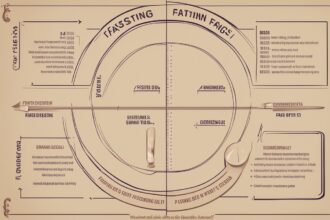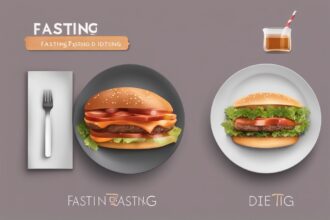When it comes to achieving health and weight loss goals, the debate between fasting and dieting often takes center stage. Among the myriad of strategies, intermittent eating approaches have gained significant attention for their flexibility and potential benefits. In this post, we’ll dive deep into Comparing Intermittent Eating Approaches, exploring how intermittent fasting stacks up against traditional dieting methods. Whether you’re looking to shed pounds, improve metabolic health, or simply adopt a sustainable eating pattern, understanding these approaches can help you make an informed decision.
What Are Intermittent Eating Approaches?
Intermittent eating approaches refer to dietary patterns that cycle between periods of eating and fasting or significant calorie restriction. Unlike traditional diets that often focus on what you eat, intermittent eating emphasizes when you eat. The most popular form is intermittent fasting (IF), which includes methods like the 16/8 method (fasting for 16 hours and eating during an 8-hour window) and the 5:2 diet (eating normally for five days and restricting calories on two non-consecutive days). On the other hand, traditional dieting often involves consistent calorie reduction or specific food group restrictions, such as low-carb or low-fat diets. Comparing intermittent eating approaches helps highlight their unique timing-based framework versus the content-based focus of conventional diets.
Health Benefits of Intermittent Fasting
Intermittent fasting has been linked to a range of health benefits beyond weight loss. Research suggests that IF can improve insulin sensitivity, reduce inflammation, and even promote cellular repair through autophagy. By giving the digestive system a break, IF may also support gut health. Many individuals report increased energy and mental clarity during fasting periods. When comparing intermittent eating approaches, IF often stands out for its potential to address metabolic issues without requiring drastic changes to food choices. For more on the science behind fasting, check out our detailed guide on Fasting Benefits for Overall Health.
Advantages of Traditional Dieting
Traditional dieting, while sometimes seen as outdated compared to trendy fasting methods, still holds significant value. Diets like the Mediterranean or DASH diet focus on balanced nutrition and long-term lifestyle changes rather than temporary restrictions. They often provide structured meal plans, which can be easier for beginners to follow. Additionally, traditional diets may be more suitable for individuals with specific medical conditions requiring consistent nutrient intake. Comparing intermittent eating approaches reveals that traditional dieting offers more flexibility in timing but demands greater attention to food quality and portion control. Learn more about balanced eating in our post on Healthy Diet Basics.
Challenges and Drawbacks of Each Approach
While both intermittent fasting and traditional dieting have their merits, they also come with challenges. Intermittent fasting can be difficult to sustain, especially for those new to fasting, as hunger pangs and irritability are common during adjustment periods. It may also not be suitable for everyone, particularly individuals with certain health conditions or those prone to disordered eating. On the other hand, traditional dieting often requires meticulous tracking of calories or macros, which can feel tedious and lead to “diet fatigue.” Comparing intermittent eating approaches shows that both methods require commitment and may not yield results if not tailored to individual needs. For tips on overcoming diet challenges, read our article on Overcoming Common Dieting Struggles.
Sustainability and Lifestyle Fit
One of the most critical factors in choosing a dietary strategy is sustainability. Intermittent fasting can be highly sustainable for some due to its simplicity—there’s no need to count calories or eliminate food groups. However, it may disrupt social eating or conflict with work schedules. Traditional dieting, while more adaptable to daily routines, often demands consistent effort in meal planning and preparation. When comparing intermittent eating approaches, consider your lifestyle, preferences, and long-term goals. A hybrid approach, combining elements of both, might even be the best solution for some. Explore personalized diet strategies in our guide to Creating Custom Diet Plans.
Which Approach Is Right for You?
Ultimately, the choice between intermittent fasting and traditional dieting depends on your individual needs, health status, and preferences. If you thrive on structure and enjoy regular meals, a traditional diet might be the better fit. Conversely, if you prefer flexibility and can handle periods of hunger, intermittent fasting could be a game-changer. Comparing intermittent eating approaches isn’t about declaring a winner but finding what aligns with your body and lifestyle. Consulting with a healthcare professional or nutritionist can provide further clarity, especially if you have underlying health concerns. For additional insights, check out our comparison of Fasting vs. Calorie Restriction.
Disclaimer: The information provided in this post is for educational purposes only and should not be considered medical advice. Always consult with a qualified healthcare professional or nutritionist before starting any new diet or fasting regimen, especially if you have pre-existing health conditions or are pregnant or breastfeeding. Individual results may vary, and what works for one person may not work for another.
References
- Harvard Health Publishing – Intermittent Fasting: Surprising Update
- Mayo Clinic – Mediterranean Diet: A Heart-Healthy Eating Plan
- NCBI – Effects of Intermittent Fasting on Health, Aging, and Disease
- American Heart Association – DASH Diet Guidelines
- WebMD – Diet vs. Fasting: What’s the Difference?
This content is for informational purposes only and not a substitute for professional advice.






